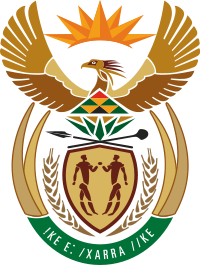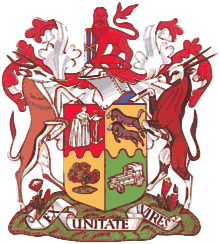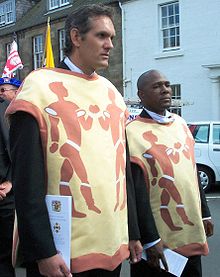- Coat of arms of South Africa
-
Coat of Arms of South Africa 
Versions 
Seal of the President of South AfricaDetails Armiger Republic of South Africa Adopted 2000 Crest Rising Sun Helm King Protea Escutcheon Khoisan rock art depicting two men greeting Supporters Elephant tusks and ears of wheat Motto ǃke e: ǀxarra ǁke Other elements Crossed spear and knobkierie Earlier versions see below Use On all Acts of Parliament; the cover of all passports and identity documents; various government departments; notes and coins; medals The present coat of arms of South Africa was introduced on Freedom Day April 27, 2000. It replaced the earlier national arms, which had been in use since 1910.[1] The motto ǃke e: ǀxarra ǁke is written in the Khoisan language of the ǀXam people and translates literally to "diverse people unite". The previous motto, in Latin, was Ex unitate vires, translated as "unity is strength".
Contents
1910 arms
The first coat of arms was granted by King George V by Royal Warrant on 17 September 1910.[2] This was a few months after the formation of the Union of South Africa.
It was a combination of symbols representing the four provinces (formerly colonies) that made up the Union.
- The first quarter is the figure of Hope, representing the Colony of the Cape of Good Hope.
- The two wildebeests of the second quarter represent Colony of Natal.
- The orange tree in the third quarter was used as the symbol of the Orange Free State Republic.
- The wagon in the fourth quarter represented the Transvaal.
- The supporters are taken from the arms of the Orange River Colony and the Cape Colony.
- The lion holds four rods, bound together, symbolizing the unification of the four former colonies.
The motto, Ex Unitate Vires was officially translated as "Union is Strength" until 1961, and thereafter as "Unity is Strength".
2000 arms
The design process was initiated when, in 1999, the Department of Arts, Culture, Science and Technology requested ideas for the new coat-of-arms from the public. A brief was then prepared based on the ideas received, along with input from the Cabinet. The Government Communication and Information System then approached Design South Africa to brief ten of the top designers. Three designers were chosen to present their concepts to the Cabinet. Iaan Bekker's design was chosen.
The new arms were introduced on Freedom Day, 27 April 2000. The change reflected government's aim to highlight the democratic change in South Africa and a new sense of patriotism.
The coat of arms is a series of elements organised in distinct symmetric egg-like or oval shapes placed on top of one another. The completed structure of the coat of arms combines the lower and higher oval shape in a symbol of infinity. The path that connects the lower edge of the scroll, through the lines of the tusks, with the horizon above and the sun rising at the top, forms the shape of the cosmic egg from which the secretary bird rises. In the symbolic sense, this is the implied rebirth of the spirit of the great and heroic nation of South Africa.
The coat of arms is also a central part of the Seal of the Republic, traditionally considered to be the highest emblem of the State. Absolute authority is given to every document with an impression of the Seal of the Republic on it, as this means that it has been approved by the President of South Africa. Since 1997, however, the use of the Seal of the Republic has not actually been required by the Constitution, but it continues to be used.
In 2006, the State Herald of South Africa, Themba Mabaso, and the Deputy Herald, Marcel van Rossum, donned a tabard with the arms of the republic at the XXVIIth International Congress of Genealogical and Heraldic Sciences in St Andrews, Scotland.
The motto's green is extended by pairs of elephant tusks. Within it are two ears of wheat and a golden shield with Khoisan rock art of two greeting human figures from the Linton stone. Above the shield is a crossed knobkierrie and spear, protea, secretary bird, and a rising sun.
The oval shape of foundation
The first element is the motto, in a green semicircle. Completing the semicircle are two symmetrically placed pairs of elephant tusks pointing upwards. Within the oval shape formed by the tusks are two symmetrical ears of wheat, that in turn frame a centrally placed gold shield.
The shape of the shield makes reference to the drum, and contains two human figures from Khoisan rock art. The figures are depicted facing one another in greeting and in unity.
Above the shield are a spear and a knobkierie, crossed in a single unit. These elements are arranged harmoniously to give focus to the shield and complete the lower oval shape of foundation.
- The motto
- The motto is: !ke e: /xarra //ke, written in the Khoisan language of the /Xam people, literally meaning "diverse people unite". It addresses each individual effort to harness the unity between thought and action. On a collective scale it calls for the nation to unite in a common sense of belonging and national pride - unity in diversity.
- The ears of wheat
- An emblem of fertility, it also symbolises the idea of germination, growth and the feasible development of any potential. It relates to the nourishment of the people and signifies :the agricultural aspects of the Earth.
- Elephant tusks
- Elephants symbolise wisdom, strength, moderation and eternity.
- The shield
- It has a dual function as a vehicle for the display of identity and of spiritual defence. It contains the primary symbol of our nation.
- The human figures
- The figures are depicted in an attitude of greeting, symbolising unity. This also represents the beginning of the individual’s transformation into the greater sense of :belonging to the nation and by extension, collective humanity.
- The spear and knobkierie
- Dual symbols of defence and authority, they in turn represent the powerful legs of the secretary bird. The spear and knobkierie are lying down, symbolising peace.
The oval shape of ascendance
Immediately above the oval shape of foundation, is the visual centre of the coat of arms, a protea. The petals of the protea are rendered in a triangular pattern reminiscent of the crafts of Africa.
The secretary bird is placed above the protea and the flower forms the chest of the bird. The secretary bird stands with its wings uplifted in a regal and uprising gesture. The distinctive head feathers of the secretary bird crown a strong and vigilant head. The rising sun above the horizon is placed between the wings of the secretary bird and completes the oval shape of ascendance.
The combination of the upper and lower oval shapes intersect to form an unbroken infinite course, and the great harmony between the basic elements result in a dynamic, elegant and thoroughly distinctive design. Yet it clearly retains the stability, gravity and immediacy that a coat of arms demands.
- The King protea'
- The protea is an emblem of the beauty of our land and the flowering of our potential as a nation in pursuit of the African Renaissance. The protea symbolises the holistic :integration of forces that grow from the Earth and are nurtured from above. The most popular colours of Africa have been assigned to the protea – green, gold, red and black.
- The secretary bird
- The secretary bird is characterised in flight, the natural consequence of growth and speed. It is the equivalent of the lion on Earth. A powerful bird whose legs - depicted as the :spear and knobkierie - serve it well in its hunt for snakes, symbolising protection of the nation against its enemies. It is a messenger of the heavens and conducts its grace upon :the Earth. In this sense it is a symbol of divine majesty. Its uplifted wings are an emblem of the ascendance of our nation, while simultaneously offering us its protection. It is :depicted in gold, which clearly symbolises its association with the sun and the highest power.
- The rising sun
- An emblem of brightness, splendour and the supreme principle of the nature of energy, it symbolises the promise of rebirth, the active faculties of reflection, knowledge, good judgement and willpower. It is the symbol of the source of life, of light and the ultimate wholeness of humanity.
References
- ^ Brownell, F.G. (1993). National and Provincial Symbols
- ^ Government Gazette no 58 (15 November 1910)
External links
Coats of arms and emblems of Africa Sovereign
states- Algeria
- Angola
- Benin
- Botswana
- Burkina Faso
- Burundi
- Cameroon
- Cape Verde
- Central African Republic
- Chad
- Comoros
- Democratic Republic of the Congo
- Republic of the Congo
- Côte d'Ivoire (Ivory Coast)
- Djibouti
- Egypt
- Equatorial Guinea
- Eritrea
- Ethiopia
- Gabon
- The Gambia
- Ghana
- Guinea
- Guinea-Bissau
- Kenya
- Lesotho
- Liberia
- Libya
- Madagascar
- Malawi
- Mali
- Mauritania
- Mauritius
- Morocco
- Mozambique
- Namibia
- Niger
- Nigeria
- Rwanda
- São Tomé and Príncipe
- Senegal
- Seychelles
- Sierra Leone
- Somalia
- South Africa
- South Sudan
- Sudan
- Swaziland
- Tanzania
- Togo
- Tunisia
- Uganda
- Zambia
- Zimbabwe
States with limited
recognition- Sahrawi Arab Democratic Republic
- Somaliland
Dependencies and
other territories- Canary Islands / Ceuta / Melilla / Plazas de soberanía (Spain)
- Madeira (Portugal)
- Mayotte / Réunion (France)
- Saint Helena / Ascension Island / Tristan da Cunha (United Kingdom)
- Western Sahara
Categories:- National coats of arms
- National symbols of South Africa
- South African heraldry
Wikimedia Foundation. 2010.


